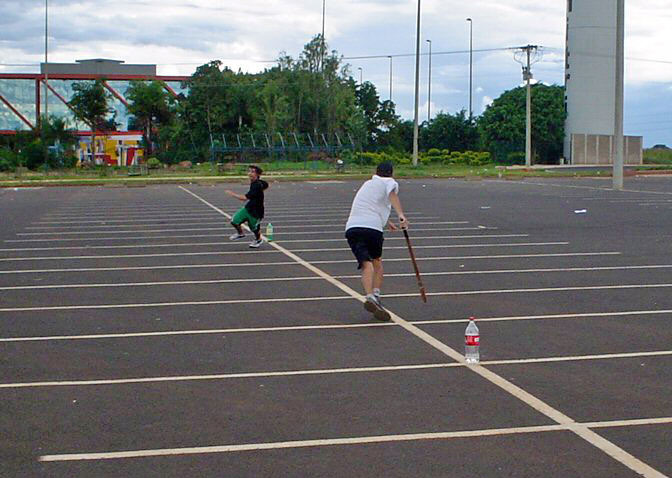Jogo De Bets on:
[Wikipedia]
[Google]
[Amazon]
 Bete-ombro, also known as bets, tacobol, pau na lata, or taco (all of these names having a word meaning "bat" in them), is a Brazilian bat-and-ball game closely related to
Bete-ombro, also known as bets, tacobol, pau na lata, or taco (all of these names having a word meaning "bat" in them), is a Brazilian bat-and-ball game closely related to
(video) Educando - Largandos os Bets
{{Forms of cricket Street cricket Sports originating in Brazil
 Bete-ombro, also known as bets, tacobol, pau na lata, or taco (all of these names having a word meaning "bat" in them), is a Brazilian bat-and-ball game closely related to
Bete-ombro, also known as bets, tacobol, pau na lata, or taco (all of these names having a word meaning "bat" in them), is a Brazilian bat-and-ball game closely related to cricket
Cricket is a bat-and-ball game played between two teams of eleven players on a field at the centre of which is a pitch with a wicket at each end, each comprising two bails balanced on three stumps. The batting side scores runs by striki ...
. Two teams of two players each take turns batting and fielding. The batting team runs between two wickets, which are generally plastic bottles (or more reminiscent of cricket, three small wooden sticks propped up so that they all lean on each other), while the fielding team can run out batters by hitting a wicket with the ball before the closest batter reaches it. (As there are only two players on the batting team, teams swap as soon as a batter is out.) Bowled, stumped, and caught
Caught is a method of dismissing a batsman in cricket. A batsman is out caught if the batsman hits the ball, from a legitimate delivery, with the bat, and the ball is caught by the bowler or a fielder before it hits the ground.
If the ball h ...
are other forms of dismissal
Dismissal or dismissed may refer to:
Dismissal
*In litigation, a dismissal is the result of a successful ''motion to dismiss''. See motion
*Termination of employment, the end of employee's duration with an employer
**Dismissal (employment), ter ...
.
Prince Harry played it on a trip to Brazil. Taco has been credited with helping to grow and influence women's cricket in Brazil.
Overview
There has been a "World Cup of Bets" held in Brazil, with teams from four cities, in 2016. When introducing cricket to Brazilian audiences, Brazilian media sometimes compare it to bete-ombro. Bete-ombro may have been more popular in the 1990s than it is now.Rules
Each of the two fielding players stands behind one of the wickets (called "alvos" (targets) or "casinha" (small house) in Portuguese), and each of the batters in front of one of the wickets. Whichever fielder has the ball throws it to the batter at the opposing wicket, with the other fielder being a de facto wicketkeeper. The batter may try to hit the ball; if he misses, he must place his bat in his crease to avoid being stumped (unlike cricket, the batter's body can't be used for this purpose), which is generally a circle drawn on the ground in front of the wicket. If the batters decide to run, they must cross bats with each other every time they pass each other, with the batters scoring a point every time both of them run from their crease to the opposing crease. Similar to the Bat flip#Cricket, there is the "wet or dry" method of deciding which team bats first in bete-ombro: first, one side of the bat is wetted, and then the bat is thrown up in the air. The team that correctly calls whether the wet or dry side of the bat will fall face-up chooses whether to bat or bowl first. (Unlike a cricket bat, both sides of the bete-ombro bat are flat, so it wouldn't be possible to call "Hills or Flats"). There is a rule reminiscent ofstrikeout
In baseball or softball, a strikeout (or strike-out) occurs when a batter accumulates three strikes during a time at bat. It usually means that the batter is out. A strikeout is a statistic recorded for both pitchers and batters, and is deno ...
s in baseball: if the ball goes behind the batter 3 times, then they are out. The game ends when one team gets 12 or 25 points, though there may be additional conditions.
In culture
In some parts of Brazil, the expression "largar os betes" (to drop the bats) is used to mean "to give up".See also
* Plaquita - a very similar version of cricket played in the Dominican RepublicReferences
External links
(video) Educando - Largandos os Bets
{{Forms of cricket Street cricket Sports originating in Brazil